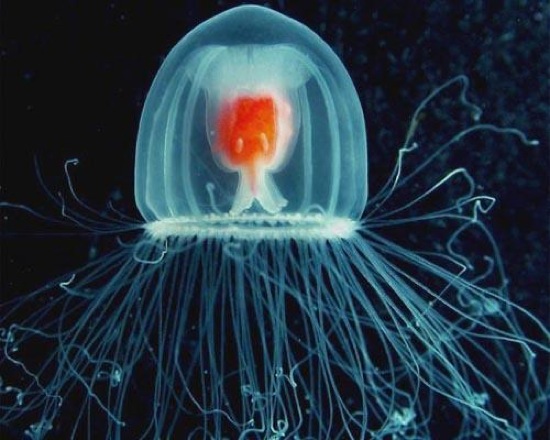
Despite science’s best efforts to understand and prevent aging (and society’s own obsession with youthfulness!), it turns out that a simple jellyfish species, Turritopsis nutricula, has had it figured out for millions of years. Appearing as a dime sized parachute, Turritopsis nutricula, or the “immortal jellyfish,” is able to revert back to its immature polyp state after reaching sexual maturity in response to adverse conditions… indefinitely. It is the only known metazoan (multicellular organism) capable of doing this, through a process called cell transdifferentiation. Hydras are also known to avoid senescence, but they do not have the unique ability to reverse their life cycle repeatedly as the Turritopsis nutricula do. The Turritopsis nutricula body, or “umbrella,” first inverts itself, followed by resorption of the tentacles and mesoglea. The inverted jellyfish affixes itself to a hard substrate at the opposite end of the umbrella, forms a perisarc sheet and stolons, then produces new polyps to form the basis for a new colony. These new polyps can recycle this process, grow more stolons, and give rise to even more polyps to create a fully fledged hydroid colony.
Of course, this is only theoretical longevity… in reality, most of these jellyfish die from predation or disease. Lately, however, the Turritopsis nutricula population has soared (whether this is simply due to their recent discovery or a reduction in their normal causes of death is unclear). Moreover, their range has increased because of their introduction to new territories from discharged ballast water, thereby swarming beyond their native Caribbean regions.
Jellyfish aside, the really cool concept behind this is cell transdifferentiation: when a non-stem cell transforms into a different type of cell, or when an already differentiated stem cell defers from its original differentiation pathway to another. Cell transdifferentiation is a rare event in both nature and in the laboratory, but does occur, for example, during fetal development of the oesophagus in humans, pigs, cats, horses and dogs. In fact, Barrett’s metaplasia arises from a maladaptive transdifferentiation event in which epithelial cells of the oesophagus switch to intestinal mucin-secreting goblet cells. Adults suffering from this condition are susceptible to adenocarcinomas with an 80% mortality rate. In addition, cystitis glandularis is another metaplastic transformation pertaining to mucosal cells lining the bladder. Experiments where salamander and chicken lens cells are removed found that iris cells would switch type and regrow as replacement lens cells. A better understanding of the mechanisms behind transdifferentiation has beneficial implications for society at large, from more successful transplants to controlling diabetes. And of course, thanks to this overrunning jellyfish species, scientists may have an excellent model to investigate this fascinating process!

One Comment on “A Jellyfish Species Possessing Eternal Life?”